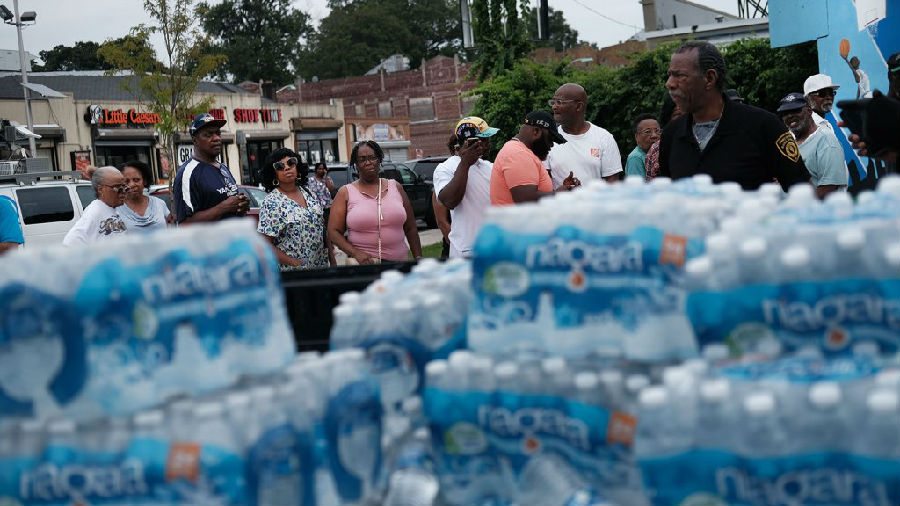United States
美國版塊
Water
水
With the lead piping
使用鉛水管
Millions of Americans still get their drinking water from lead pipes
數(shù)百萬美國人仍然通過鉛水管獲得飲用水
Over a century has passed since the dangers of consuming lead became widely known. Ingesting even small quantities damages young brains and may raise the risk of heart problems. Yet residents of Chicago—and many other cities—still mostly swig from taps fed by lead pipes. About 400,000 lead service lines connect to the mains in the Windy City, linking about four in five of all houses there. One study of nearly 3,000 homes, two years ago, found two-thirds had elevated levels of lead in their water.
一個多世紀(jì)以來,攝入鉛的危險已經(jīng)廣為人知。即使少量攝入也會損害年輕人的大腦,并可能增加心臟問題的風(fēng)險。然而,芝加哥和許多其他城市的居民仍然主要是從鉛水管連接的水龍頭中喝水。風(fēng)城大約有40萬條含鉛服務(wù)線路連接著城市的主干線,連接著大約五分之四的房屋。兩年前,一項(xiàng)對近3000戶家庭的研究發(fā)現(xiàn),芝加哥三分之二家庭的水中鉛含量升高。
In Chicago some residents are told to flush their taps before drinking, to fit filters or avoid boiled water (doing so can concentrate higher levels of lead). Older houses in poorer districts may be worst affected. Since this problem has been identified for so long,why does it persist? The city’s water woes can be blamed in part on the historic clout of industrial lobbyists and a union of plumbers. In the last century, even as other cities stopped installing the pipes or started removing them, they nudged Chicago’s political bosses to set rules making lead pipes compulsory. That lasted until a federal ban on new lead pipes in 1986. More than three decades on, Lori Lightfoot recently became the first mayor to set out a plan to fix things. The catch? It will cost $8.5bn, which the city government does not have. At the current pace of replacing fewer than 800 pipes a year, notes an alderman, residents won’t all get lead-free water until the mid-26th century.
芝加哥政府告知部分居民在飲用前沖洗水龍頭,安裝過濾器或避免使用開水(這樣做會使鉛濃度更高)。貧困地區(qū)的老房子可能受影響最為嚴(yán)重。既然這個問題已經(jīng)被發(fā)現(xiàn)這么久了,為什么還會一直存在?芝加哥的水資源問題可以部分歸咎于工業(yè)游說人員和水管工人聯(lián)合會的歷史影響力。上個世紀(jì),就在其他城市停止安裝或開始拆除鉛水管時,他們敦促芝加哥的政治領(lǐng)袖們制定規(guī)定強(qiáng)制使用鉛水管。這一規(guī)定一直持續(xù)到1986年,聯(lián)邦政府禁止新安裝鉛水管。三十多年過去了,洛里·萊特福特最近成為第一位提出計劃以解決飲用水含鉛問題的市長。該計劃有什么隱情?這項(xiàng)計劃將耗資85億美元,而市政府卻沒有這么多資金。一位市議員指出,按照目前每年更換不到800根鉛水管的速度,居民們要到26世紀(jì)中葉才能全部獲得無鉛水。

Mayors are more alert to the problem these days, especially since the water crisis in 2014 in Flint, Michigan exposed residents to high levels of lead leaching from their pipes. Flint is spending $100m upgrading its system. Erik Olson of the Natural Resources Defence Council, who has campaigned on the issue for 30 years, says thousands of water systems across the country, serving tens of millions of people, still face “serious problems”. The new attention to the problem encourages him.
如今,市長們對這一問題更加警惕,特別是密歇根州弗林特市在2014年曾爆發(fā)一次飲水危機(jī),使居民們被迫使用水管中鉛含量超標(biāo)的水。弗林特市花費(fèi)1億美元升級其用水系統(tǒng)。自然資源保護(hù)委員會的埃里克•奧爾森30年來一直在領(lǐng)導(dǎo)運(yùn)動致力于解決這一問題,他說,美國數(shù)以千計的供水系統(tǒng)服務(wù)著數(shù)千萬美國人,但該系統(tǒng)仍然面臨“嚴(yán)重的問題”。政府對用水問題的重新關(guān)注鼓勵了他。
譯文由可可原創(chuàng),僅供學(xué)習(xí)交流使用,未經(jīng)許可請勿轉(zhuǎn)載。











